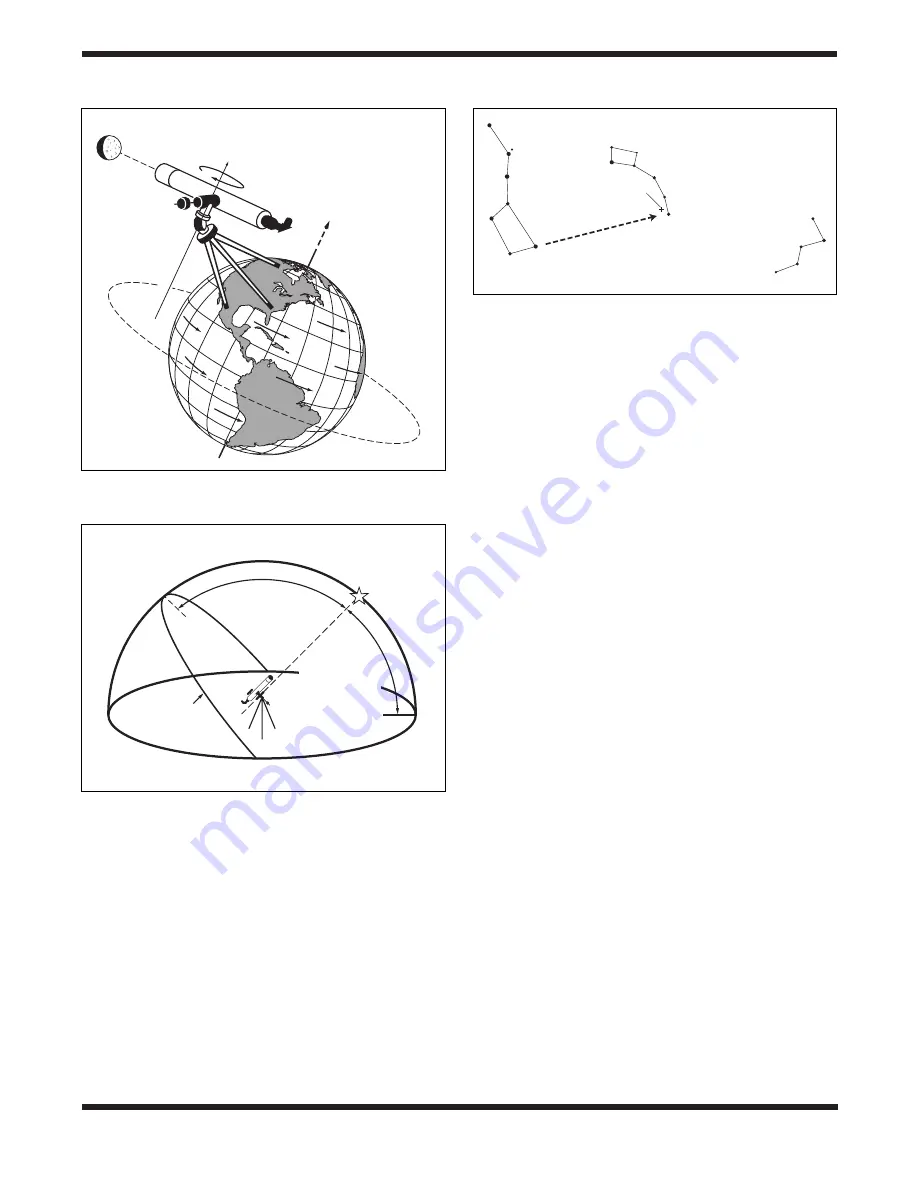
Polar Alignment
For Northern Hemisphere observers, approximate polar
alignment is achieved by pointing the mount’s R.A. axis at the
North Star, or Polaris. It lies within 1° of the north celestial
pole (NCP), which is an extension of the Earth’s rotational
axis out into space. Stars in the Northern Hemisphere appear
to revolve around the NCP.
To find Polaris in the sky, look north and locate the pattern of
the Big Dipper (Figure 9). The two stars at the end of the
“bowl” of the Big Dipper point right to Polaris.
Observers in the Southern Hemisphere aren’t so fortunate to
have a bright star so near the south celestial pole (SCP). The
star Sigma Octantis lies about 1° from the SCP, but it is barely
visible with the naked eye (magnitude 5.5).
To polar-align the Observer 60mm EQ:
1. Level the equatorial mount (5) by adjusting the length of
the three tripod legs (9).
2. Loosen the latitude lock T-bolt (28). Turn the latitude
adjustment T-bolt (29) and tilt the mount until the pointer
on the latitude scale is set at the latitude of your observing
site. If you don’t know your latitude, consult a geographical
atlas to find it. For example, if your latitude is 35° North,
set the pointer to 35. Then retighten the latitude lock T-bolt.
The latitude setting should not have to be adjusted again
unless you move to a different viewing location some dis-
tance away.
3. Loosen the Dec. lock knob (24) and rotate the telescope
optical tube (1) until it is parallel with the R.A. axis, as it is
in Figure 1. The pointer on the Dec. setting circle (21)
should read 90°. Retighten the Dec. lock lever.
4. Loosen the azimuth lock knob (30) at the base of the
equatorial mount(5) and rotate the mount so the telescope
tube (and R.A. axis) points roughly at Polaris. If you can-
not see Polaris directly from your observing site, consult a
compass and rotate the mount so the telescope points
North. Retighten the azimuth lock knob.
The equatorial mount is now polar aligned.
From this point on in your observing session, you should not
make any further adjustments in the azimuth or the latitude of
the mount, nor should you move the tripod. Doing so will undo
the polar alignment. The telescope should be moved only
about its R.A. and Dec. axes.
Use of the R.A. and Dec. Slow-Motion Control
Cables
The R.A. and Dec. slow-motion control cables (7,8) allow fine
adjustment of the telescope’s position to center objects within
the field of view. Before you can use the cables, you must
manually “slew” the mount to point the telescope in the vicini-
ty of the desired target. Do this by loosening the R.A. and
13
Figure 7.
When properly polar-aligned, the equatorial mount can
easily “track” objects by compensating for the rotation of the earth.
to P
o
lar
is
Celestial Eq
uator
Equa tor
EQ mount moves in the opposite
direction of the Earth's rotation.
Right Ascension Axis
Figure 8.
Polar alignment of the Observer 60mm EQ is easily
done by pointing the telescope’s right ascension axis at Polaris (The
North Star).
R
igh
t A
sce
nsio
n
A
xi
s
90
°
Pole to Equator
Polaris
(The North Star)
Celestial
Equator
Horizon
Angle from the ground
to the North Star is the
same as your latitude.
Your EQ mount's latitude
should match this angle.
S
N
E
W
S
E
W
N
Figure 9.
To find Polaris in the night sky, look north and find the
Big Dipper. Extend an imaginary line from the two "Pointer Stars"
in the bowl of the Big Dipper. Go about five times the distance
between those stars and you'll reach Polaris, which lies within 1°
of the north celestial pole (NCP).
Big Dipper
(in Ursa Major)
Little Dipper
(in Ursa Minor)
Cassiopeia
N.C.P.
Pointe
r
Stars
Polaris
Содержание Observer 60mm EQ
Страница 2: ...2 ...
Страница 4: ...4 2 4 8 6 7 Observer 60mm Refractor 11 10 3 9 Figure 1 Observer 60mm EQ components 5 1 12 ...
Страница 19: ...19 ...





































